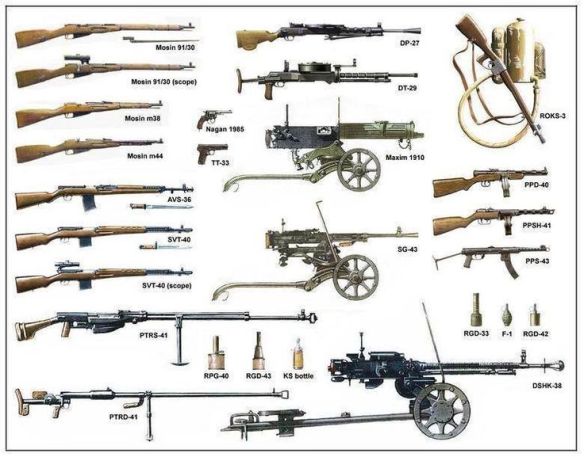Soviet Small Arms.
StG 44
The Germans had already noted the Russian success with machine pistols (submachine guns). The major shortcoming of the machine pistol was that it was, in fact, a pistol with a longer barrel and a larger magazine (thirty or more rounds). Despite the longer barrel, the pistol cartridge lacked accuracy, even when fired from the hip in bursts of automatic fire. The pistol cartridge also lacked punch. Where a rifle bullet would kill a man, a pistol round would only wound. And the wounded soldier would often keep firing back. The assault rifle round (beginning with the MP-43/StG-44) was not quite as powerful as the standard rifle round, but more powerful than a pistol round. This made a big difference for the infantry, as the assault rifle could be fired at longer ranges with more accuracy and stopping power.
World War II began with most infantry operating as they had in the closing days of World War I. Four years later, it became obvious that infantry operations had to go through another transformation, just as they had done in the last year of World War I. By the end of that war, it had finally been realized that infantry could not just charge ahead through enemy artillery and machine-gun fire. First the enemy had to be smashed with carefully, and quickly, placed artillery fire. The infantry could then advance around remaining enemy strongpoints and into the rear area. Tanks had been introduced late in World War I and became the principal offensive weapon early in World War II. Firepower had increased since World War I. The big German problem was that they were running out of infantry. The Germans ran out of troops first, but the Russians were in the same situation and were down to the dregs when the war ended. Both sides came to the same conclusions about resolving the shortage of infantry and using more firepower and fewer troops. For the Russians, this meant massive artillery bombardments against the German lines before the Russian infantry went into action. The Russians also massed tanks, moving these in front of and among the infantry to give the foot troops some additional protection. Russian infantry were given more personal firepower by increasing the number of machine guns and submachine guns (automatic pistols, small rifles firing pistol-type cartridges) in the infantry divisions. The growth of machine guns and submachine guns in Russian divisions was like this:
Weapons per 1,000 Men in Russian Divisional Organizations
Submachine Guns Machine Guns
May 1941 83 44
December 1942 234 69
June 1944 250 68
Russian infantry losses were still horrendous, but without these additional weapons, the casualties would have been worse, mainly because fewer Germans would have been killed and wounded. Mortars and guns were also increased, as well as the number of tanks and assault guns added to infantry divisions assigned to major attacks.
The Russians actually saw these changes before the war began. Their 1939 infantry division organization had no submachine guns and only forty-one machine guns per 1,000 troops. The disastrous war with the Finns in 1940 had something to do with this, but a lot of credit should go to a very bright bunch of senior Soviet officers (who had managed to survive Stalin’s purges in the late 1930s).
At the beginning of the war in Russia, the Germans indisputably had the superior infantry, and it took a while before they noticed they had a problem with infantry losses beyond those caused by the stren uous conditions in Russia. German officers noted the higher proportion of submachine guns in Russian divisions (more than twice what the Germans had, until 1945, when the Germans closed the gap). The generals called for more firepower for the infantry, from submachine guns to mortars, artillery, assault guns, and tanks. But more critical was the shortage of good officers for the infantry. This was a problem in all armies. Even the Germans, who had the best infantry officers of any army, saw the need for better leadership in the infantry companies. The problem was made worse by the very high casualties in the infantry. Officers were lost even more quickly than troops because of the German practice of officers being up front most of the time. Since officers were the major force in raising the training level of the troops, the lack of enough officers put a greater burden on the NCOs and gradually caused the Germans’ qualitative edge in infantry to decline. While the Russians never were able to match the infantry skills of the Germans, the Russians closed the gap as the war ground on and, until the end, had superior numbers.
The ultimate solution was to be found in the Panzergrenadier (motorized infantry) divisions. These units could carry all the additional weapons and ammunition the infantry needed to survive on the battlefield, and they had something of an armored punch of their own (usually in the form of armored assault guns, but occasionally in the form of some tanks). Perhaps most important, these motorized infantry units could keep up with the panzer (tanks) divisions and do those chores tanks weren’t good at, like occupying ground, rooting enemy infantry out of fortifications and built-up areas, and beating off counterattacks. But Germany did not have the resources to form many of these. The German Army remained, until the end of the war, a largely horsedrawn army. By late 1944, far more submachine guns were added to German infantry divisions, as well as a higher proportion of mortars and assault guns. But it was not soon enough. The German infantry melted away in combat faster than it could be replaced or reformed.
